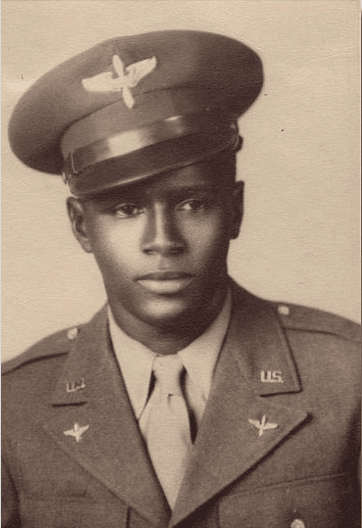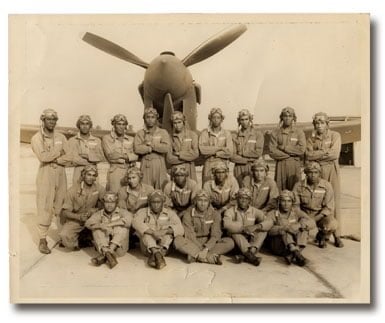 James H. Harvey, III
James H. Harvey, III
July 13, 1923 –
Class 44-1-1-SE
Graduation date: 10/16/1944
Rank at time of graduation: 2nd Lt.
Unit: 99th Fighter Squadron of the 332nd Fighter Group
Service # 0838153
From: Mountain Top, PA
Harvey was born in Montclair, New Jersey, on 13 July. His family moved to Nuangola Station, Pennsylvania, in 1936 and was the only African-American family in that region. Harvey excelled in high school by becoming senior class president and valedictorian. He was drafted into the Army in April 1943, where he was first introduced to prejudice and discrimination. Harvey boarded a train in Pennsylvania bound for Fort Meade and ultimately Washington, DC. The train stopped in Washington D.C. so “all Negroes could be moved to the last car on the train,” he said, “This was my first experience with active racism. I didn’t like it and I never forgot it.”
After taking all of the required draftee tests, Mr. Harvey was assigned to the US Army Air Corps – but not as a pilot. Rather, he was to be an engineer who would carve airstrips out of the jungles of the Pacific. He reapplied for cadet training, and after taking the Cadet Training Exam at Bolling Field, he was accepted for flight training at Moton Field, Alabama. He graduated from Flying School at Tuskegee Army Air Field as a second lieutenant on 16 October 1944. Following graduation, he was assigned to the 99th Fighter Squadron, Godman Field, Kentucky, where he flew the P-47.

Class 44-I-SE1 order unknown: Cornelius D. Dowling, Henry A. Hunter, Ferrier F. White, Rutherford H. Adkins, Thomas J. Daniels III, Edward D. Doram, Robert M. Glass, James H. Harvey, Jr., Frank A. Jackson Jr., Theodore W. Lancaster, Charles E. Miller, Joseph M. Millett, Charles P. Myers, Richard A. Simons, Richard G. Stevens, Charles L. Stovall, Donald L. Thompson Jr., Richard E. Thorpe, Allen H. Turner, James W. Warren
His unit’s deployment to Europe was put on hold in April of 1945 because the war was almost over. They were scheduled to go to Okinawa to fly support for the fall push into Japan, but the A-bombs over Japan ended that war.
On May 11, 1949, sufficient traction had been made politically to officially end segregation in the US military with the signing of Executive Order 9981. This ground breaking ruling came after a constant barrage of complaints, lawsuits and political pressure from African-Americans who were banned from serving in the US Army Air Corps because of their race. This ruling meant that the 99th Fighter Squadron would be disbanded and its members integrated fully into operational squadrons. In a final exhibition of excellence, the men of the 332nd Fighter Group selected three primary members to participate in the first ever USAF Weapons Meet at Nellis Air Force Base: First Lieutenant James Harvey, III, First Lieutenant Harry Stewart, Jr., and Captain Alva Temple. First Lieutenant Halbert Alexander was an alternate pilot.
The team from the 332nd placed first, winning the meet flying F-47Ns against other more advanced aircraft. However, the men were not fully recognized for their accomplishment until 1995, when the US Air Force archives were updated officially documenting their victory. Harvey’s recollections of the 1949 gunnery meet are clear and pointed. He said, “B.O. Davis [Jr.] only half-jokingly told us not to come back to Lockbourne if we didn’t win. We all knew how much was riding on this contest. We flew hard to earn each point. Also, I can’t say enough about our ground crew personnel, led by Buford Johnson. We got a pretty good night’s sleep each night, but Buford and his team never rested until they had those planes in great shape for the next day’s contests. And then they were back with us early each day since we flew in the mornings to avoid the worst of the desert heat.”
Harvey gained combat experience in the Korean War. He was the military’s first black jet fighter pilot to fly in Korean airspace. On 16 October 1950, he led an element of four F-80s in close support to a bomber mission under adverse weather to attack enemy troops three miles north of Yongsan, Korea. Flying with a low ceiling of 800 feet, Captain Harvey’s flight found the enemy encampment and immediately inflicted heavy damage. For this engagement he was awarded the Distinguished Flying Cross along with multiple Air Medals. In all, Lieutenant Colonel Harvey would net eleven Air Medals in his Air Force career due to his many engagements with adversary forces. After the Korean War, he served as a flight commander, test pilot, assistant group operations officer, flight safety officer, and Battle Staff Training Officer for the Commanding General of NORAD. During his career he flew many aircraft, including the P-51, which he flew during a tour at Williams AFB in Arizona. Lieutenant Colonel Harvey retired on 31 May 1965, after twenty-two years of service. He currently resides in Denver, Colorado.
He was at AirVenture Oshkosh in 2012 and saw the Mustang and the RISE ABOVE Traveling Exhibit. “I think the Squadron does very good work. I particularly like how the Squadron makes a point of making sure people understand the role of the support personnel. A pilot is only as good as the team on the ground, particularly the crew chief. Mine was Buford Johnson, who still lives in California.”
MORE INFORMATION
Gunnery Meet – Las Vegas Air Force Base, Nevada May 2, 1949
May 2, 1949 Gunnery Scores
See the Virtual Museum posting of the trophy
Be sure to visit his personal website!
Archive photos courtesy of the Air Force Historical Research Agency, Maxwell AFB, Alabama
TUSKEGEE AIRMAN INTERVIEW FOLLOW UP: For those that missed this powerful MUST-SEE-TV which originally aired on January 25, 2012, we are pleased to follow up to post this in-depth interview with Original Tuskegee Airmen, L/Col. James Harvey III, and Col. John Mosley, with Denver’s own, Tamara Banks, on “Studio 12” live TV talk show on PBS/Colorado Public Television, channel 12.
The CAF Red Tail Squadron is a volunteer-driven organization dedicated to educating audiences across the country about the history and legacy of the Tuskegee Airmen, America’s first black military pilots and their support personnel.





